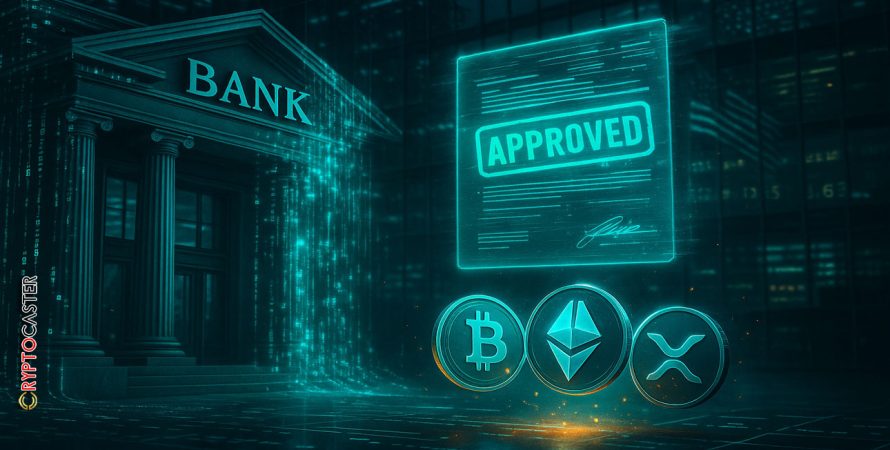By CryptoCaster Editorial Desk | November 18, 2025
U.S. banking regulators have taken a quiet but consequential step toward mainstream digital-asset adoption. In a new interpretive update, the Office of the Comptroller of the Currency (OCC) confirmed that national banks may now hold certain crypto assets on their own balance sheets, provided the holdings are operational, limited, and tied directly to blockchain network fees required for permitted banking activities.
Stay in the know on crypto by frequently visiting Crypto News Today
While the move falls short of authorizing broad speculative exposure, it represents the clearest federal acknowledgment yet that modern banking increasingly depends on networks that are powered by native digital tokens.
CryptoCaster Quick Check:
A Narrow but Meaningful Shift
According to the guidance, banks may maintain “reasonably necessary amounts” of native blockchain tokens — such as Bitcoin, Ethereum, or others — strictly for paying network gas fees or for testing and validating custody or settlement systems the bank intends to offer.
That distinction matters.
Banks aren’t being invited into token speculation. Instead, regulators are recognizing something unavoidable:
if banks want to operate on modern rails, they must occasionally touch native tokens.
This is especially true for custody platforms, tokenized-asset systems, blockchain settlement routines, and compliance-layer networks that rely on decentralized infrastructure.
Why the Approval Matters
For years, banks have been locked in a regulatory gray zone.
They could explore blockchain infrastructure, but touching the tokens required to run that infrastructure was either discouraged or unclear.
This new guidance does three important things:
1. Legitimizes operational token exposure
Banks can now hold tokens when necessary to operate on networks they are legally permitted to use.
2. Reduces compliance uncertainty
Institutions no longer need to rely on workaround arrangements, third-party intermediaries, or off-balance-sheet token management.
3. Opens the door for wider infrastructure adoption
Expect renewed interest in tokenized settlement rails, bank-grade custody systems, and interoperable payment networks.
It is not a regulatory big bang — but it is the type of clarity that unlocks quiet but powerful institutional movement.
What This Is Not
Regulators were equally clear about what this approval doesn’t do:
- Banks cannot hold crypto as a speculative investment vehicle.
- Holdings must be de minimis relative to capital.
- Activities must fit within traditional banking authority frameworks.
- All token interactions remain subject to risk-management, AML/KYC, key-control, and board-oversight requirements.
In other words:
Operational exposure is allowed. Speculative exposure is not.
Broader Policy Context
This guidance lands within a broader U.S. shift toward a more structured digital-asset regulatory environment:
- The GENIUS Act established a federal framework for payment-stablecoins.
- Banking regulators issued unified expectations for crypto-asset safekeeping and custody.
- Supervisory agencies have begun removing older crypto-specific guardrails that had slowed bank experimentation.
Together, these moves suggest regulators are not accelerating — but they are clearing the runway.
What to Watch Next
- Which major banks begin testing token-based settlement rails?
- Whether the Fed issues parallel clarity on wholesale settlement and tokenized deposits.
- If U.S. institutions seek broader authority to hold assets like ETH or BTC for liquidity purposes.
- How quickly bank-grade custody platforms move from pilot to production.
If history is a guide, regulatory clarity — even in narrow form — precedes adoption, not the other way around.
The OCC may have opened only a single door, but for the banking sector and the crypto ecosystem, that door has been stuck for years.
And now, finally, it moves.
If this article brought you clarity, insight, or value—support the work that made it possible.
At CryptoCaster, we report on Web3, crypto markets, and institutional finance with no billionaire owners, no shareholders, and no hidden agenda. While mainstream media bends toward Elon Musk, BlackRock, and JPMorgan narratives, we stay focused on what matters: truth, transparency, and the public interest.
We don’t just cover the headlines—we investigate the power structures behind them. From FTX and Ripple to the quiet push for CBDCs, we bring fearless reporting that isn’t filtered by corporate interests.
CryptoCaster is 100% paywall-free. Always has been. To keep it that way, we depend on readers like you.
If you believe independent crypto journalism matters, please contribute—starting at just $1 in Bitcoin or Ether. Wallet addresses are below.
Your support keeps us free, bold, and accountable to no one but you.
Thank you,
Kristin Steinbeck
Editor, CryptoCaster
Support CryptoCaster: The Unfolding of Money
At CryptoCaster.world, we’re dedicated to bold journalism, sharp insights, and fearless commentary across blockchain, Web3, and crypto markets. Your **Bitcoin contributions** help us stay independent and continue delivering signal over noise.
🚨 CryptoCaster does not offer investment advice. Always DYOR—volatility is real, and risk tolerance matters.
Support our mission. Contribute BTC today.
🔗 Bitcoin Address:
3NM7AAdxxaJ7jUhZ2nyfgcheWkrquvCzRm
Thank you for backing our journalistic lens as we chronicle the Unfolding of Money — a saga still being written in real time.![]()
CRYPTOCASTER HEATMAP








